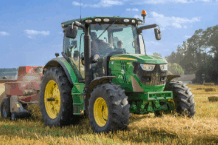MANHATTAN, Kan. – Lower prices paid to farmers for their crops in 2014 pulled average net farm income in Kansas below previous year levels and well below the five-year average, according to the Kansas Farm Management Association.
Net farm income across 1,175 KFMA member farms averaged $122,190, down from $140,356 the previous year and below the five-year average of $149,114, KFMA’s annual PROFITLINK Analysis showed. An executive summary of the report is available online at http://www.agmanager.info/kfma/.
“Average net farm income for the state was down about $18,000 in 2014 compared with 2013,” said Kevin Herbel, KFMA program administrator, adding that most of the pressure came from lower crop prices.
KFMA divides the state into six regions. Net income last year was down in four of the six regions while southeast Kansas and northwest Kansas farms had higher income than the previous year. South central Kansas farms had the lowest at $52,996, a sharp drop from $151,464 a year earlier. Southeast Kansas farms had the highest net income last year at $183,899.
Not all Kansas farms are KFMA members, but the annual report is a barometer of financial conditions for producers, especially when comparing one year to the next, Herbel said.
While crop prices were down in 2014, livestock prices were higher, which aided producers who raise cattle, particularly.
One state, different regions
“Historically, whatever the wheat crop does, that’s how the KFMA numbers move,” said Bryan Manny, KFMA economist in south central Kansas, where the average farm income was the lowest. “Last year the average wheat yield (in south central) was about 26 bushels per acre, whereas in 2013, the average yield was 47 bushels per acre. Last year’s yield was the lowest since 2007 when there was a late freeze and the average yield was 14.6 bushels per acre.”
Despite the slide, most producers are weathering the storm well, Manny said of farmers in his area. Over the last few years, some producers have shifted some of their acres to crops other than wheat and the rains in June and July last year helped those spring-planted crops.
“Farmers are also not spending a lot on equipment right now,” he added.
Average net farm income in northeast Kansas last year tallied $149,476, not much change from the previous year of $160,350, said Clay Simons, a KFMA economist in that area.
“Primarily, producers had tremendous yields in the face of lower prices which helped,” Simons said, adding that some cattle producers in northeast Kansas received Livestock Forage Disaster payments (http://www.fsa.usda.gov/Internet/FSA_File/lfp_2014_fbill.pdf) because of drought conditions. Those payments, along with historically high cattle prices provided a boost last year.
“The average (cattle) farm in northeast Kansas received $29,010 in forage loss payments,” Simons said. “That was a nice economic shot in the arm for them.”
Despite the relatively strong net farm income last year in northeast Kansas, however, producers know things can change and are being cautious, he said.
“Corn with a $3 (price) in front of it is certainly different than with a $6 or $7 in front of it,” he added, noting that fertilizer and other input prices, as well as rent and land prices, have not dropped in tandem with crop prices.
The average price paid to U.S. farmers for their corn in the 2013-2014 marketing year was $4.46 per bushel, down from $6.89 the previous year. USDA projects the 2014-2015 average price to dip even further, to $3.55 to $3.75 per bushel.
“We (northeast Kansas) had a nice buffer with yields and livestock prices last year but we can’t count on that forever,” Simons said, adding that most producers have been prudent with their finances and that balance sheets are generally in good shape.
Dave Rempe, KFMA economist in north central Kansas said that area did not have a great wheat crop in 2014, where average net farm income slipped to $102,508 from $137,633 the previous year. “That, along with feedgrain commodity prices were the reasons we were down. We would have been down more if not for the livestock prices. Fortunately that helped our income.”
Despite lower income in 2014, $102,508 was a good year considering the size farms in that part of the state, Rempe said.
“Our farms are in really good shape to weather this storm financially,” he said. “We’ve seen this coming. People are cautious. A lot of economic activity, such as equipment purchases, has slowed as people are anticipating a drop in income. There’s a chance we’ll see deterioration of our balance sheets, but we’re going into it in a very strong position.”
Net income by operation
The KFMA member data for 2014 also showed:
- The value of production across Kansas farms came in at an average of $613,243, down from both $631,437 a year earlier and $639,282 two years earlier. The 2014 number was, however, above the five-year average of $606,792.
- Net income for dryland crop producers averaged $91,811, down from $161,069 in 2013.
- Net income for producers who irrigate averaged $118,608, down from $125,628 in 2013.
- Average net income for 36 producers whose operations are primarily cow herds jumped to $177,047 from $92,612 a year earlier.
- Net income for producers who grow crops and have a cow herd averaged $155,677 compared with $73,005 the previous year.
- Net income for the 19 KFMA member producers who grow crops and background calves averaged $321,206, sharply higher than a year earlier at $71,719.
-30-
K State Research and Extension is a short name for the Kansas State University Agricultural Experiment Station and Cooperative Extension Service, a program designed to generate and distribute useful knowledge for the well being of Kansans. Supported by county, state, federal and private funds, the program has county Extension offices, experiment fields, area Extension offices and regional research centers statewide. Its headquarters is on the K State campus in Manhattan.
Story by:
Mary Lou Peter
mlpeter@ksu.edu
K-State Research and Extension
http://www.ksre.ksu.edu/



